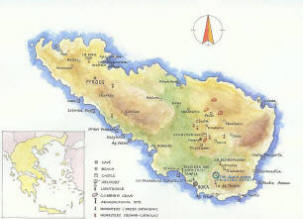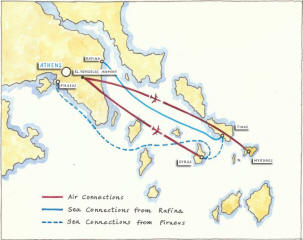|

Tinos / Cyclades: overview (click to enlarge)



Tinos / Clyclades: Travel information (click to enlarge)
www.openseas.gr
Characteristics
◊
Unrivalled natural environment
◊
Distinctive cultural heritage
◊
ca. 65 mostly traditional settlements
◊
Proximity to the Greek ports, Piraeus, Rafina and
Lavrion: in the triangle of islands Syros, Tinos and Andros,
Attica’s “maritime suburbs”
Links
◊
Tinos The Aegean Muse
◊
Tinos ABOUT
◊
Tinos Secret
◊
The official site of the Holy Church of Panagia of Tinos
◊
Cultural Foundation of Tinos
◊
Chamber of Cyclades |
Τinos – A Monument of
Culture and Natural Beauty
For nature-lovers, Tinos is an
absolute paradise, as it is also for artists and for all
those who seek a tranquil lifestyle on an island endowed
with a genuine Cycladic character and atmosphere and a rich
history and cultural and intellectual tradition. Tinos, just
a stone’s throw away from cosmopolitan Mykonos,
geographically an extension of the island of Andros and
lying northeast of the island of Syros, is the third largest
island of the Cyclades. With a total land surface area of
200 km2, a coastline of 105 km and about 8,000 permanent
residents, Tinos possesses a very special magnetism thanks
to its alluring landscapes, its brilliant sunlight and
pleasant climate, its rich cultural past, its great
diversity of local traditions and its quite unique
architecture. This array of captivating features is truly
exceptional among the Greek islands.
A Uniquely Enchanting Setting
On the island of Tinos, the visitor is literally dazzled by
a mosaic of alternating images of natural beauty, of
picturesque traditional gleaming-white villages, of magical
seashores, of the unparalleled brightness of the light that
pervades all, of the sea that acts as a vast reflector of
the sun, of the cerulean-blue sky. Scattered chapels and
ornate dovecotes (built for the breeding of pigeons, these
are veritable ‘works of embroidery’ in stone) adorn the
scenery of the island. All this in combination also with the
endless rows of drystone-walled terraces creates a single
“sculptured” environment, which accounts for the well-known
Greek philosopher Cornelius Castoriades’ characterization of
Tinos as the “handcrafted island”. Tinos is indeed a place
that emphasizes the aesthetic of stone working: the
stone-built boundaries of the fields, the chapels, the
dovecotes, the “kelia” (local name for old-time dwellings or
stables) are all lovingly and highly creatively fashioned
out of the local stone. Meanwhile, the famous Tinian marble,
of various shades of green, white and grey, is to be found
composing and/or adorning numerous buildings.
Culture: Spotlight
on Marble Sculpting
Marble
carving and sculpting developed on the island during
the latter period of Venetian rule, reaching its
zenith in the 19th century when this art spread
beyond the bounds of Tinos and reached the Holy
Mountain of Athos, Constantinople, Egypt, Russia,
North America and many other places round the world,
leaving everywhere its imprint on lintels,
altarpieces, fountains, tombstones, plaques in large
cemeteries of Greece, in churches of the Greek
diaspora, even on the Acropolis. Numerous of the
foremost marble sculptors and representatives of
modern Greek sculpture, such as Chalepas,
Philoppotes, Lytras, Sochos, the Vitalis brothers
and many more, have dedicated works that still today
embellish important buildings of Athens, among which
the Archaeological Museum, the National Art Gallery,
the Polytechnic School, the Zappeion Exhibition
Hall, the Old Palace/present-day Parliament, the
University and the National Academy. Today, the art
of marble sculpting and carving is preserved
unaltered through time thanks to the Pyrgos School
of Fine Arts and the many marble sculptors who, in
their workshops, process and shape the marble of the island.
A Center of
Orthodoxy
Tinos is
also one of the most important centers of Greek
Orthodoxy. The Church of the Panagia Megalochari
with the miraculous icon of the Virgin Mary, whose
blessing pervades the entire island, is a pole of
attraction for thousands of pilgrims from round the
world each year.
Tinos - Delos
In
antiquity, Tinos was renowned as being a stop-off
point of worship for the faithful on their way to
Delos, the great devotional center of the age, of
pan-Hellenic religious significance. Today, the
uninhabited island of Delos forms a museum in itself
of enormous attraction for every history enthusiast
thanks to its numerous archeological remains and
ongoing excavations: it is only half an hour from
Tinos by ship and one hour by caique. Near Kionia
beach and the ancient port of Tinos are the ruins of
the Doric temple dedicated to the god Poseidon.
Must-see
attractions / Not to miss:
Here is a short
roundup of only a very few of the countless sights
that visitors will gradually discover during their
stay on this island of Greek tradition and art.
-
The very numerous dovecotes of the island
(over six hundred of them), a remarkable example of
traditional Tinian architecture.
-
The Temple of Poseidon and Amphitrite,
which is dated to the 5th c. BC, at Kionia, near the
‘Chora’ (capital) of Tinos.
-
The Archaeological Museum, on the road
leading from the port to the Church of the Panagia/Virgin
Mary Megalochari, which houses a rich collection of
exhibits from antiquity as well as findings from the
Temple of Poseidon.
-
Τhe Museum of Tinian Arts, in Pyrgos, where
one has the opportunity to admire great works by
painters and sculptors, such as Ghyzis, Chalepas,
Vitalis, Philippotis and Sochos.
-
The house and museum of Giannoulis Chalepas,
with works and personal belongings of the famous
sculptor, in Pyrgos.
-
Τhe churches and chapels of Tinos, over
2,000, the most important one being the church of
the Panagia/Virgin Mary Megalochari the ‘Chora’
(capital) of Tinos.
-
At Volakas (Volax), the lunar-like landscape
with immense, rounded granite boulders, the result
of a globally unique geological formation.
|